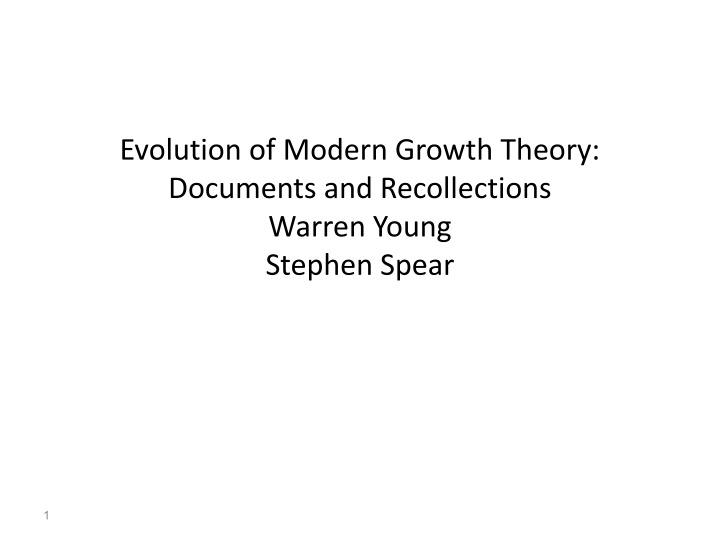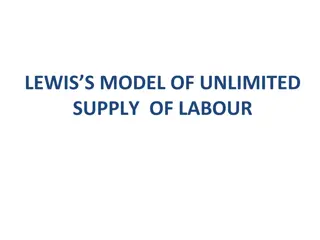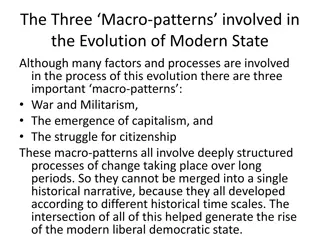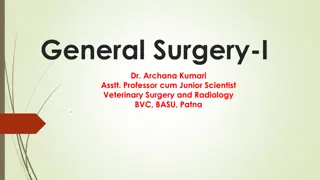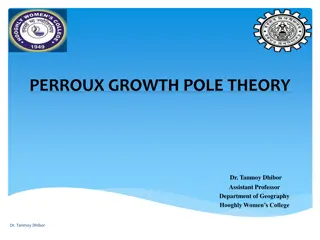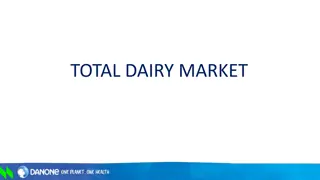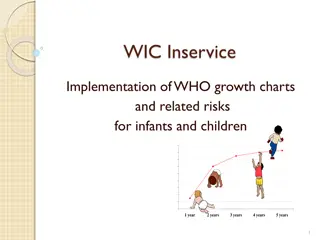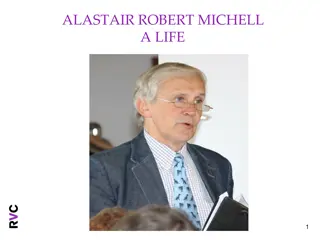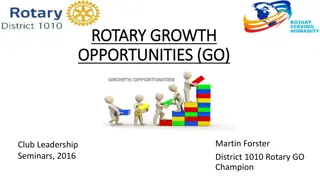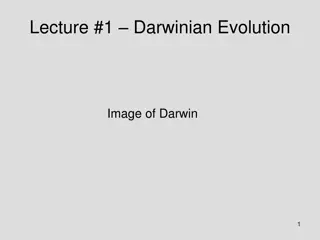Evolution of Modern Growth Theory - Documents and Recollections
Hicks, Solow, Hahn, and the evolution of modern growth theory are explored through recollections, documents, and sequential cross-fertilization. The reconstruction of historical narratives in modern economics is highlighted, including interpretations of Mr. Keynes, real business cycle models, and macroeconomic dynamics.
Download Presentation

Please find below an Image/Link to download the presentation.
The content on the website is provided AS IS for your information and personal use only. It may not be sold, licensed, or shared on other websites without obtaining consent from the author.If you encounter any issues during the download, it is possible that the publisher has removed the file from their server.
You are allowed to download the files provided on this website for personal or commercial use, subject to the condition that they are used lawfully. All files are the property of their respective owners.
The content on the website is provided AS IS for your information and personal use only. It may not be sold, licensed, or shared on other websites without obtaining consent from the author.
E N D
Presentation Transcript
Evolution of Modern Growth Theory: Documents and Recollections Warren Young Stephen Spear 1
Some background: Hicks, Solow, Hahn, Hagiography and Sequential Cross-fertilization Hicks (1973) Recollections and Documents , Economica: Memory is treacherous I have tried to reconstruct the story with the aid of documents [our emphasis] Solow (1984) Mr Hicks and the Classics , OEP [First Hicks Lecture, Oxford, 3 May 1984]: At the very same meeting of the Econometric Society in Oxford in September 1936, there were three papers that tried to extract a model from the General Theory Harrod s Meade s [and Hicks ] It is not too far- fetched to say that the same basic equations could be detected in all three versions. At some celestial level of abstraction, they could be described as identical products. But it was the IS-LM model that established itself as out trained intuition Perceived Gedanken Process: Multiple Discovery [based upon his Solow-Swan weltanschauung] Young and Hahn, Cambridge Faculty Tea Room , December 1985: Young: Frank take a look at these [Hicks letter to Meade dated 6 Sept 36 regarding seeing Harrod s and Meade s conference papers, using Harrod s equations, Meade s notation , and I shall be obliged to produce it [Hicks paper] out of a hat ; found misfiled in Meade s papers at LSE; and Arthur Brown s notes on Hicks CC- LL paper, found in his attic] Hahn: Young you are a Hagiographer Young: Frank how do you define that? Hahn: One who deals with ancient and sacred documents Actual Gedanken Process: Sequential Cross-fertilization 2
Reconstruction For the past three decades, I have been engaged in the reconstruction of the historical narratives of some areas in modern economics, as manifest in: -Interpreting Mr Keynes: the IS-LM Enigma Polity-Blackwell, Oxford, England, and Westview Press,USA,1987; Japanese translation,1994,Taga-Shuppan, Tokyo -Harrod and his Trade Cycle Group: the origins and development of the growth research program Macmillan, London, and New York University Press,USA,1989 -Oxford Economics and Oxford Economists (with Fred Lee) Macmillan, London,1993 -Economics, Economists and Expectations: microfoundations to macroapplications (with William Darity Jr. and Robert Leeson) Routledge, London, 2004; characterized by sequential discovery and cross-fertilization -Real Business Cycle Models in Economics, Routledge, London, 2014; characterized by sequential discovery and cross-fertilization -Freshwater Economics: the Evolution of Quantitative Macroeconomics (in preparation) 3
Macroeconomic Dynamics [MD] Panel Sessions at ASSA In order to implement further reconstruction , we organized a number of ASSA-MD panel sessions: Rational Expectations: Retrospect and Prospect" (ed. Young and Hoover), Macroeconomic Dynamics, 17,5, 2013, based on panel session with Lucas, Wallace, Shiller, Mortensen and Lovell. "Real Business Cycles after Three Decades", (ed. Young and Altug) Macroeconomic Dynamics, 19 ,2, 2015 , based on panel session with Prescott, Kydland, Long, Plosser, Hansen and Cooley. "Optimal Growth after 50 years" (ed. Young and Spear), Macroeconomic Dynamics [forthcoming] based on panel session with Shell, Romer, Mirman, Durlauf, Khan and Galor 4
Narratives of Modern Growth Theory Conventional narratives and conflations -Harrod (1939) and Domar (1946) -Solow (1956) and Swan (1956) -Ramsey (1928)- Cass (1965) Koopmans (1965) -Arrow (1962)-Lucas (1985/88)-Romer(1986-1990) Characterized by perceived multiple and/or sequential discovery Based upon diachronic analysis of published papers only 5
Reconstructed Narratives diachronic analysis based upon all available documents and recollections Cass interview with Spear and Wright, MD (1998): So I just put the two together [ optimal growth problem and Pontryagin maximum principle ]and then Uzawa thought this was great. I m not sure why, I guess probably because Tjalling Koopmans was working on this problem and Tjalling was a bit of an idol for Uzawa. Actually, Uzawa liked to one-up people. At some point he was talking to Tjalling about the problem, and Tjalling was describing what he was doing and Uzawa interrupted and said, Well, I have a graduate student who did that problem. Then Tjalling got very nervous about it, he was always very nervous about . . ., oh, authorship and who was first and that sort of thing, and we had some correspondence. 6
Macroeconomic Dynamics Surveys on Modern Growth Theory "Optimum Savings and Optimal Growth: the Cass-Malinvaud-Koopmans Nexus" Macroeconomic Dynamics, 2013(with Stephen Spear) "Two Sector Growth, Optimal Growth and the Turnpike: amalgamation and metamorphosis", Macroeconomic Dynamics, 2014 (with Stephen Spear), Generalizations of Optimal Growth Theory: Stochastic Models, Mathematics and Meta-synthesis , Macroeconomic Dynamics, 2015 (with Stephen Spear) "Endogenous Growth Theory and Models: the 'First Wave', 1952-73" Macroeconomic Dynamics, 2017 (with Stephen Spear) Endogenous Growth Theory and Models: Transformation and Methodenstreit -the Second Wave , 1974-1994 Macroeconomic Dynamics, 2019 (with Stephen Spear), forthcoming 7
OPTIMUM SAVINGS AND OPTIMAL GROWTH: THE CASS MALINVAUD KOOPMANS NEXUS This paper surveys the contributions of David Cass, Tjalling Koopmans, and Edmond Malinvaud over the decades during which modern optimal growth theory was developed. By utilizing material ranging from dissertations, drafts, and working papers through conference presentations, discussions, and published papers, we show that both Malinvaud and Cass had significant impacts on the evolution of Koopman s thought, and the development of his part of what is known as the Cass Koopmans model. Based on our findings, we conclude that the modern optimal growth model should include the contributions of Malinvaud, and be retitled the Cass Malinvaud Koopmans model accordingly. 8
From conclusion to OPTIMUM SAVINGS AND OPTIMAL GROWTH: THE CASS MALINVAUD KOOPMANS NEXUS Indeed, the scenario we presented here is probably as old as science itself. On the one hand, we see a serious and motivated young graduate student in Dave Cass, striking out to solve a problem he probably thought no one else had thought of or worked on, using the newly developed mathematical techniques pioneered by Pontryagin and his students. In Tjalling Koopmans we find an established and revered senior scientist also tackling the same problem with a clear understanding of its import and history, but lacking the up-to-date mathematical tools needed to fully solve the problem. In Edmond Malinvaud, we have a true pioneer who formulated and solved a version of the discrete-time growth model without the aid of Pontryagin s mathematics, but whose practice of publishing much of his work in his native French limited the exposure of his work. In terms of the cross fertilization that resulted from the communications we have outlined here, Cass clearly benefitted from Koopmans s knowledge of the history of his subject and the pioneering role that Frank Ramsey played in developing the early growth model. Koopmans, in turn, benefitted from Cass s grasp of the new mathematics; indeed, Cass s work showed Koopmans explicitly that there was an application for the new mathematics of Pontryagin. Malinvaud s understanding of the importance of transversality conditions for infinite-horizon growth models allowed him to identify Koopmans error in the initial draft of his Vatican paper [as presented at the Oct. 1963 Vatican conference, as manifest in the form of Koopmans CFDP 163 (Dec. 1963). Original error ( counterexample ) pointed out by Malinvaud in discussion of paper published in Vatican volume, albeit error corrected by Koopmans in published 1965 version] The sequential communication between Cass, Koopmans, and Malinvaud, mediated by the conference process, resulted in a model that put growth on a fully general equilibrium footing. In the process, it revolutionized the study of growth and set a standard for dynamic economic analysis that has been followed ever since. 9
TWO-SECTOR GROWTH, OPTIMAL GROWTH, AND THE TURNPIKE: AMALGAMATION AND METAMORPHOSIS -This paper deals with the development of growth models from the optimal one-sector neoclassical approach of Cass Malinvaud Koopmans vintage, through two-sector, multisector, and turnpike models, and proceeds to discuss their displacement by the single-sector stochastic growth model. -We also focus on the definitional shift regarding the turnpike. This is done by surveying both unpublished and published work by Uzawa, Cass, Koopmans, and McKenzie regarding growth and the turnpike, the cross-fertilization between them, and how this brought about the conflation of optimality and the turnpike, and the metamorphosis of the notion of the turnpike, from that of Dorfman Samuelson-Solow, to the Koopmans McKenzie amalgam of models. -Finally, the appearance of endogenous growth models, based on the work of Shell and Uzawa, is dealt with. 10
GENERALIZATIONS OF OPTIMAL GROWTH THEORY: STOCHASTIC MODELS, MATHEMATICS, AND METASYNTHESIS -This paper deals with the evolution of the classical growth research program of Ramsey Cass Koopmans vintage via its stochastic variants and generalizations [Samuelson (1976, note 1)]. Thus, here we trace the origins and impact of the stochastic generalization that brought about a paradigm shift in modern economics, and still generates significant research in the form of quantitative macroeconomics, that is to say, real business cycle theory (RBC henceforth),and its metamorphosis into the dynamic stochastic general equilibrium (DSGE)approaches of both new classical and New Keynesian vintage. a). 11
Optimal stochastic growth modelscontinued -Our focus, then, is on the origins and development of optimal stochastic growth models in continuous-time and discrete-time forms. The paper is divided into three sections. -The first section deals with unpublished and published papers by Phelps (1960a, 1960b, 1961, 1962a, 1962b), and Mirrlees (1965a, 1965b). Phelps s unpublished Cowles Foundation Papers on both continuous-time and discrete-time stochastic optimal growth (1960b, 1961) are also dealt with in this context the former never published, the latter the basis for his 1962 Econometrica paper. 12
Optimal stochastic growth modelscontinued -We then deal with Mirrlees unpublished papers, dating from 1965, which had a significant impact on subsequent work in the area of stochastic optimal growth, such as on the contributions of Merton, Mirman, and Brock and Mirman. Mirrlees s use of the conceptual and mathematical tools provided by Wiener, Doob, and Ito is also dealt with, as they still influence the financial economics developed by Merton based upon them. Merton s contributions (1969, 1975) to the continuous-time approach are also dealt with in this section. 13
Optimal stochastic growth modelscontinued -The second section deals with the application of the dynamic programming approach of Bellman and Blackwell over the period 1952 1970, its application to economic planning and growth models, especially by Radner, over the period 1963 1974, and cross-fertilization between Radner, Brock, and Mirman. -The third section tells the story of how Brock and Mirman developed their watershed approach over the period 1970 1973. It surveys the development of their 1972 JET (1972b) and 1973 IER papers from their origins in their early joint work and Mirman s thesis (1970a), through conference presentation, and finally publication. This section also deals with the important, albeit little- known third Brock Mirman paper, that is, their 1971 conference paper published in the volume Techniques of Optimization (1972a). 14
Endogenous Growth Theory and Models: the First Wave , 1952 1973 This paper surveys the development of what can be considered endogenous models from 1952 to 1973, that is to say, the "first wave" of the endogenous approach, including the works of Abramovitz, Haavelmo, Kaldor, Kaldor and Mirrlees, Arrow, Frankel, Phelps, Phelps and Drandakis, and Uzawa. We then focus on the Stanford- Chicago-MIT-Yale [SCMY] nexus of growth theorists and their contributions. The graduate student summer seminars organized by Uzawa in Chicago over the period 1964-1967 are dealt with, including recollections of participants, who besides SCMY students, also included graduate students from Rochester and other institutions. 15
Endogenous Growth Theory and Models: the First Wave , 1952 1973 continued In addition, AEA and Econometric Society [ES] sessions on growth and capital theory, technical change, technical progress, theory of innovations over the period 1964-1968 are discussed. The 1967 volume edited by Shell, which included papers emanating from the Chicago groups and AER and ES meetings, by Sheshiski, Nordhaus, Cass and Yaari, and Shell himself, will be discussed. The contributions of Shell, Von-Weizacker, Sheshinski, Inada, Aoki, Nordhaus, Stiglitz, Atkinson and Stiglitz, Sidrauski, Calvo, Razin, and Nelson and Phelps, Uzawa and others over the period 1965-1973, are also surveyed. These include dissertations, working papers, technical reports, conference presentations, book chapters, and papers published by them. 16
Endogenous Growth Theory and Models: the First Wave , 1952 1973 continued We then turn to the early development of some of the building blocks of what became the "second wave" of the endogenous approach, that is endogenous technical progress, human capital, increasing returns to scale [IRTS] and imperfect competition approaches. Finally, the importance of the realization that a competitive equilibrium was not compatible with increasing returns (Shell 1965, 1973) is discussed. 17
Interim Conclusions A number of types of gedanken processes have characterized the evolution of modern growth theory: (i) Harrod-Domar - sequential discovery ; (ii) Solow-Swan - multiple discovery ; (iii) Ramsey-Cass-Malinvaud-Koopmans - sequential discovery and sequential cross-fertilization (iv) Optimal Stochastic Growth and Endogenous Growth theories- sequential discovery and sequential cross-fertilization In other words , as we show in our surveys, the evolution of modern growth theory, from the 1960s onwards, at least, occurred along lines of interactions between economists, parallel to the cases of rational expectations and real business cycle models in economics, and was not produced out of a hat , or progressed from published paper to published paper . 18
